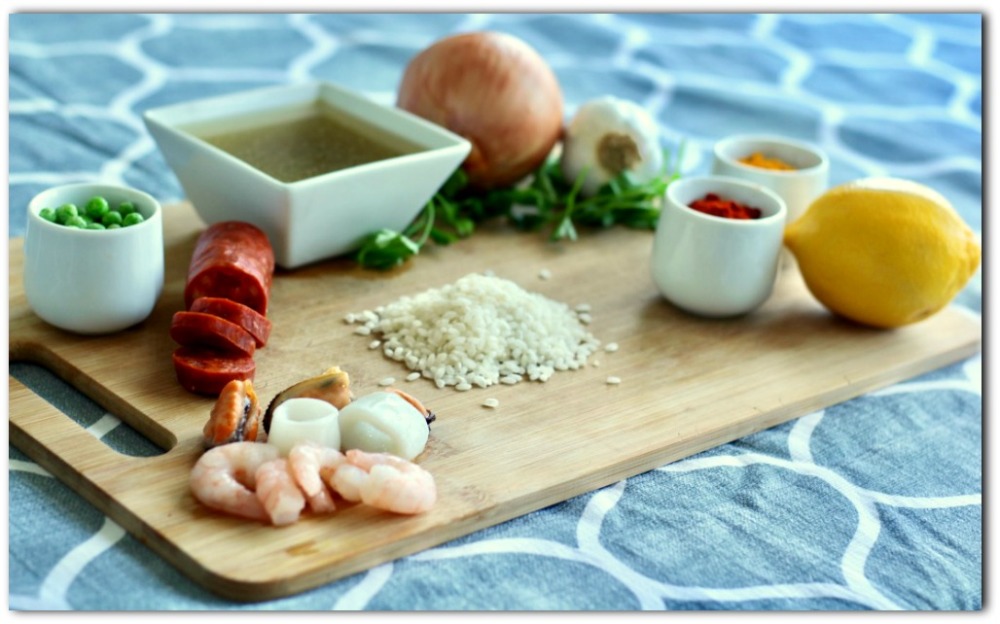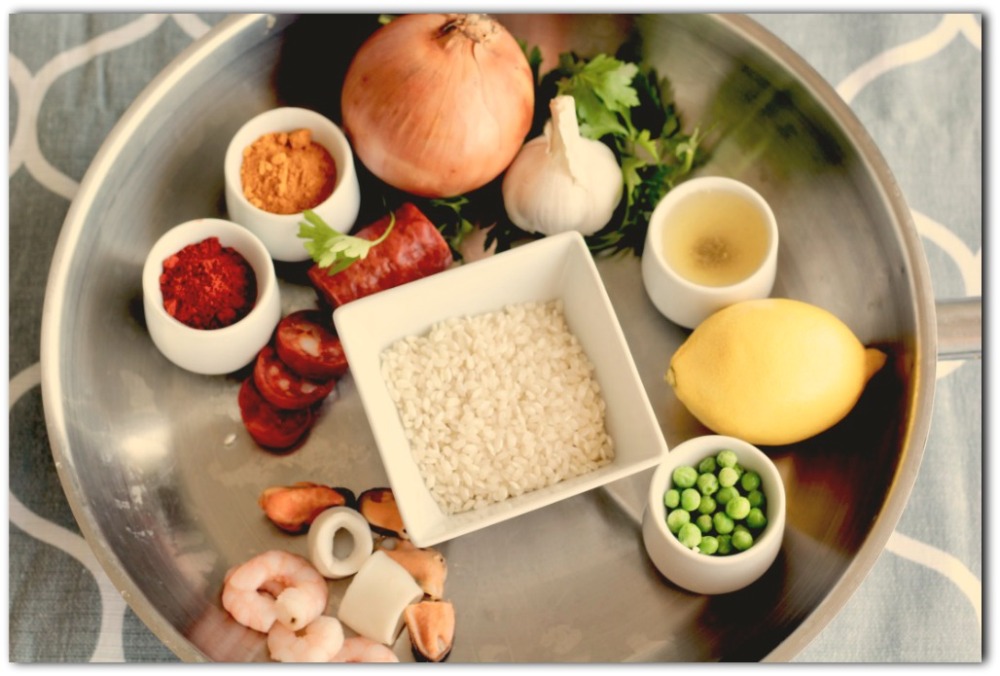During the summer of 2017, my wife and I celebrated our tenth anniversary by spending it in Fuerteventura, one of the Spanish Canary Islands just off the coast of Morocco.
 Even living in a foreign country myself, I still struggle with uncomfortable situations. It would have been easier for us to get room service or go all-inclusive at our resort. It would have been comfortable to have walked to the local Burger King which was just down the road.
Even living in a foreign country myself, I still struggle with uncomfortable situations. It would have been easier for us to get room service or go all-inclusive at our resort. It would have been comfortable to have walked to the local Burger King which was just down the road.
But I was determined to experience, enjoy, and appreciate something local and Spanish.
 Our second night out, we discovered a Spanish restaurant called El Olivo and we were recommended their paella—a very Spanish rice dish. I was unfamiliar with what this was, but we ordered a seafood paella for the both of us and we waited for our food.
Our second night out, we discovered a Spanish restaurant called El Olivo and we were recommended their paella—a very Spanish rice dish. I was unfamiliar with what this was, but we ordered a seafood paella for the both of us and we waited for our food.
Looking back, we had no idea what we were about to experience!
Paella is the epitome of the Spanish life! It’s a rice dish that was founded in Valencia more than 400 years ago. Valencia is on the eastern coast of Spain, off the Mediterranean Sea. By way of the Valencian rice and the abundance of seafood, paella has evolved over the centuries.
While the British typically have a carvery every Sunday afternoon, on Sundays in the Spanish cultures, they typically eat paella. There are even huge festivals and competitions surrounding this dish!
 The ingredients are all natural foods found in Spain. Its beautiful colours truly look like a fiesta and the large skillet it’s made in brings the whole Table together as a family!
The ingredients are all natural foods found in Spain. Its beautiful colours truly look like a fiesta and the large skillet it’s made in brings the whole Table together as a family!
 I cannot speak more highly of this culture-in-a-meal, especially when the waiter approached us with a skillet the size of our Table!!! My eyes were big because of how excited I was. Beautiful presentations and new food experiences truly excite me! Rebekah’s eyes were big because our food was staring back at us! (The squid on the top still had eyes!) We both got past the eyes. Eventually.
I cannot speak more highly of this culture-in-a-meal, especially when the waiter approached us with a skillet the size of our Table!!! My eyes were big because of how excited I was. Beautiful presentations and new food experiences truly excite me! Rebekah’s eyes were big because our food was staring back at us! (The squid on the top still had eyes!) We both got past the eyes. Eventually.
And to state that the paella was SO good would be an understatement! It was phenomenal!
Several months later, my parents ordered us a large skillet for Christmas and had it shipped to us via Amazon. It was the largest skillet I had ever had and I was envisioning all the things I could cook! It just so happened that we were having friends over later that week and I knew they liked Spanish food.
That’s when cooking paella in my own kitchen turned into a personal challenge for me and my mind went back to that wonderful summer night on the coast of Correlejo Bay.
There was the dining atmosphere—a cosy table in a Spanish restaurant.
There was the ambiance—a man quietly playing Spanish music on his guitar.
There was, of course, amazing company—my gorgeous wife 😉
And there was my first experience of paella—divine!
Not only do I love enjoying these experiences, but I love bringing these experiences to my own kitchen and Table.
To recreate paella, I had to research exactly what it was and how it was made. You don’t buy a bag of paella at your local grocery. Paella is not a better version of Ramen noodles or Kraft Mac and Cheese. You won’t find paella on the shelf with the dry rice and you won’t find it in the freezer with the frozen rice.
Paella is a beautiful creation of real food and centuries of culture.
Obviously, rice is the central ingredient but not just any rice will do. Bomba rice is what’s used in Spain. Where I shop, I buy a package of ‘Paella Rice’. Either way, the rice you will want is a short-grain rice that absorbs liquids but keeps its shape.
After that, the ingredients you use will largely depend on your preference.
 The ingredients that I choose to use are:
The ingredients that I choose to use are:
- Extra Virgin Olive Oil, a few glugs
- 1 white Onion, chopped
- 3 garlic cloves, chopped
- 15g Turmeric (1T)
- 15g Smoked Paprika (1T)
- 350g Paella Rice
- 500ml homemade chicken stock (2 cups)
- 225g Spanish Chorizo, sliced
- 350g Seafood Mix (mussels, squid, prawns)
- 100g frozen peas
- 1 Bunch of Fresh Parsley, chopped
- 1 large Lemon, cut into 4 wedges
You will also need an extra-large skillet or your very own Paella Pan, as well as a Table and 3 other friends!

A recipe card is waiting for you at the bottom!
I start out with a little bit of extra virgin olive oil in the skillet and when both the skillet and oil are hot, I throw in a chopped onion and 3 chopped garlic cloves.
At this point, things start moving quite fast.
Since the skillet is hot and I don’t want my onion and garlic burning, I quickly throw in 15 grams of Turmeric and 15 grams of Smoked Paprika and start stirring what’s in the skillet together.
Now I throw in 350 grams of Paella Rice.
(At this point, some of my American readers may be a bit confused with grams and my use of the metric system. When it comes to cooking and measurements, I challenge you to buy a small digital scale, learn the “zero” feature, and cook more efficiently. If this intrigues you, this article may be helpful, but please don’t be offended by it. )
Back to the rice . . .
There’s not much liquid to absorb at this point, but what I want is for the rice to be covered by the flavours of the onion, garlic, turmeric, and paprika.
Once this is done, I throw in 250 millilitres of stock. My wife makes her own chicken stock in bulk and then freezes it in portions of 250 ml (or 1 cup) so this is very convenient to have on hand. If you don’t have this option, you can choose to use store bought stock. I recommend vegetable or chicken stock, as opposed to beef stock.
Before I leave the skillet to simmer, I throw in the slices of Spanish chorizo. Then I cover the skillet, allowing the oils of the chorizo to mix with the stock as well as giving the rice a few minutes to soak up the flavours.
Personal Tip:
Much of this requires practise and patience. Keep the heat lower so you can watch things closer. You don’t want anything burning. You shouldn’t need to stir the rice after you mixed it with the spices and added stock. The trick is to cook it in a way that doesn’t burn it, but leaves it with a nice crispy base.
At this point, I make sure I have everything prepped and ready for the next round.
When most of the liquid is soaked up, I add more liquid to keep the food from burning as I continue to cook. You can choose to use more chicken stock (another 250 ml) or plain water works. You may even choose to use a few glugs of a Spanish white wine—the alcohol will be cooked out, but the acid will break down all the natural flavours and help enhance them.
I enjoy seafood paella like I had in Fuerteventura. Tesco, where I shop, sells a Seafood Mix in the frozen section, which includes squid, prawns, and mussels. So, as the new liquid begins to heat up, I throw these contents into the skillet with 100 grams of frozen peas.
This part works really well because as the frozen contents begin to melt, the extra water gives the rice just enough liquid to carry it to the end.
Lastly, I sprinkle the chopped parsley and place the 4 lemon wedges in the skillet at each corner for a nice presentation. Then I carry the skillet off the stove and bring it straight to the Table.
Personal Tip:
Feel free to venture out and experiment with different ingredients. Some paella includes chicken and other vegetables. Or maybe just use more of what you like and less of what you don’t like.
Recently, we invited friends over who are getting married soon. They will be spending their honeymoon in Barcelona and I felt that this meal would be perfect for celebrating their engagement.
I love sharing these food experiences with friends and family. Creating food is an Art and a passion of mine. And eating with friends and family is a true joy! So, to sit at a Table and share a meal with friends and family that I created is an incredible experience.
I also have learned to appreciate other cultures. The history, the flavours, and even the colours of paella help me to look beyond my Table and truly appreciate what this dish has meant to centuries of Spanish families at their own Tables.
In case you don’t know me, I’m not Spanish and I don’t live in a Spanish culture. But when I embrace other cultures, I start to understand people better. And when they realise that I care about their culture, a true friendship begins as we begin learning from each other.
As an American living in the UK, I must embrace the culture around me and the Table continues to be my tool. Sadly, I don’t have the privilege of sitting at a Table and eating with many of you so the next best thing I can do is share my experience of creating paella.
My hope is that you will share it with your friends and family and that you will take the time to celebrate the God who created such a colourful, diverse world, who loves us in our cultural context, and hears us through our own heart language!

de mi Mesa a tu Mesa!
[Brian]
Please leave a comment on your experience of embracing other cultures or even your experience of creating paella!
Paella Recipe Card
Photo: El Olivo, Paella Festival, the rest were taken by the Table Art Chef 😉

I printed the card – which looks great! – and I’m going to try it! It may be a disaster (at least the first time) but I’ll report back. This inspires me to want to invite some people to share it with us, too!
LikeLiked by 1 person